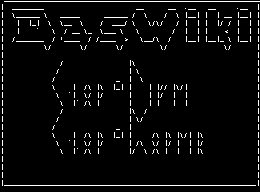Pages (Latest 10 updated) :
Menu (Edit):
- Das Wiki
- zsh.md
- zoneminder.md
- yubikey.md
- yasnippet.md
- xprofile.md
- xmonad.md
- wpa_supplicant.md
- wp3.md
- windows.md
Menu (Edit):
Link List (Edit):
Contents:
# _____ _ __ __ _ _
# |_ _| |__ ___ | \/ | __ _ __ _(_) ___ __ _| |
# | | | '_ \ / _ \ | |\/| |/ _` |/ _` | |/ __/ _` | |
# | | | | | | __/ | | | | (_| | (_| | | (_| (_| | |
# |_| |_| |_|\___| |_| |_|\__,_|\__, |_|\___\__,_|_|
# |___/
# __ __ _ _ ___ __
# \ \ / /__ _ __| | __| | / _ \ / _|
# \ \ /\ / / _ \| '__| |/ _` | | | | | |_
# \ V V / (_) | | | | (_| | | |_| | _|
# \_/\_/ \___/|_| |_|\__,_| \___/|_|
# _____ _ _ ____ _
# | ___(_) | ___ / ___| _ _ ___| |_ ___ _ __ ___ ___
# | |_ | | |/ _ \ \___ \| | | / __| __/ _ \ '_ ` _ \/ __|
# | _| | | | __/ ___) | |_| \__ \ || __/ | | | | \__ \
# |_| |_|_|\___| |____/ \__, |___/\__\___|_| |_| |_|___/
# |___/
⠀⠀⢀⠀⠀⠀⠀⠀⠀⠀⠀⠀⣀⣀⡠⢣⠀⠀⠀⠀⠀⠀⠀⠀⠀⠀⠀⠀⠀⠀
⠀⢸⢉⡗⠀⠀⠀⠀⠀⠀⠀⠀⠈⡆⠀⠈⡱⠖⠀⠀⠀⠀⠀⠀⠀⠀⣄⣠⠆⠀
⠀⠀⠀⠁⠀⠀⠀⠀⠀⠀⠀⠀⠰⠓⠒⢴⠀⠀⠀⠀⠀⠀⠀⣀⠀⠀⢨⠀⣰⠃
⠀⠀⠀⠀⠀⠀⠀⠀⠀⠀⠀⠀⠀⠀⠀⠀⠀⠀⠀⠀⠀⢀⠜⢹⡀⠀⠀⠀⠈⠀
⠀⠀⠀⠀⢠⣀⣶⠀⠀⠀⠀⠀⠀⠀⠀⢤⢀⣀⣀⣀⡠⠋⠀⠀⢇⠀⠀⠀⠀⠀
⠀⠀⠀⠀⠀⡇⣄⠊⠁⠀⠀⠀⠀⠀⢀⡨⢦⠀⠀⠀⠀⠀⠀⠀⠘⠒⠤⣀⡀⠀
⠀⠀⠀⠀⠀⠀⠈⠀⠀⠀⠀⡀⠔⠊⠁⢀⡀⠳⡀⠀⠀⠀⠀⠀⠀⠀⠀⣀⠼⠋
⠀⠀⠀⠀⠀⠀⠀⠀⣀⠔⠈⡀⠄⠂⠉⢀⡀⢰⠁⠀⠀⠀⠀⠀⠀⡴⠊⠁⠀⠀
⠀⠀⠀⠀⠀⠀⡠⢊⠠⠒⣁⠤⠐⣀⡁⠤⢤⠃⢀⣀⡠⢄⡀⠀⠀⡇⠀⠀⠀⠀
⠀⠀⠀⠀⡠⡪⢐⡡⢐⠩⠐⠊⠁⠀⠀⠀⠚⠉⠉⠀⠀⠀⠙⠢⣀⡇⠀⠀⠀⠀
⠀⠀⢠⡪⡪⡲⠕⠈⠀⠀⠀⠀⠀⠀⠀⠀⠀⠀⠀⠀⢀⠀⠀⠀⠈⠃⠀⠀⠀⠀
⠀⣰⣿⠞⠉⠀⠀⠀⠀⠀⡄⡰⡆⠀⠀⠀⠀⠀⠀⢐⣌⡶⠀⠀⠀⠀⠀⠀⠀⠀
⡰⠋⠀⠀⠀⠀⠀⠀⠀⠀⣸⠤⡐⠁⠀⠀⠀⠀⠀⠀⠀⠃⠀⠀⠀⠀⠀⠀⠀⠀
The Magical World of File Systems
A file system is a methodological construct that controls how a computational system stores and organizes information for access, reading, and writing.
As computers have evolved over the years there have been many different file systems. Some of which were either very inefficient or very unstable. These have been discarded into the proverbial wastebin, but most are still with us today. File systems are for the most part dependent on which type of medium the data is written to. Other factors that determine the file system are things such as ram availability, on board memory, and operating system.
File System Variety
There are too many file systems to list all of them here, but we will gloss over a few of the more popular ones.
- ReiserFS - A journaling filesystem designed by Hans Reiser at Namesys. Has been removed from the linux kernel.
- btrfs - A Copy-on-write filesystem intended to address lack of support for pooling, snapshots, integrity checking, datascrubbing, and multidevice spanning in linux systems. It was originally designed by Ohad Rodeh, and has slowly grown in popularity.
- Ext4/Ext3/Ext2 - The staple journaling filesystem for Linux for many years. Still default for many OSs.
 Anoduck's Das Wiki
Anoduck's Das Wiki